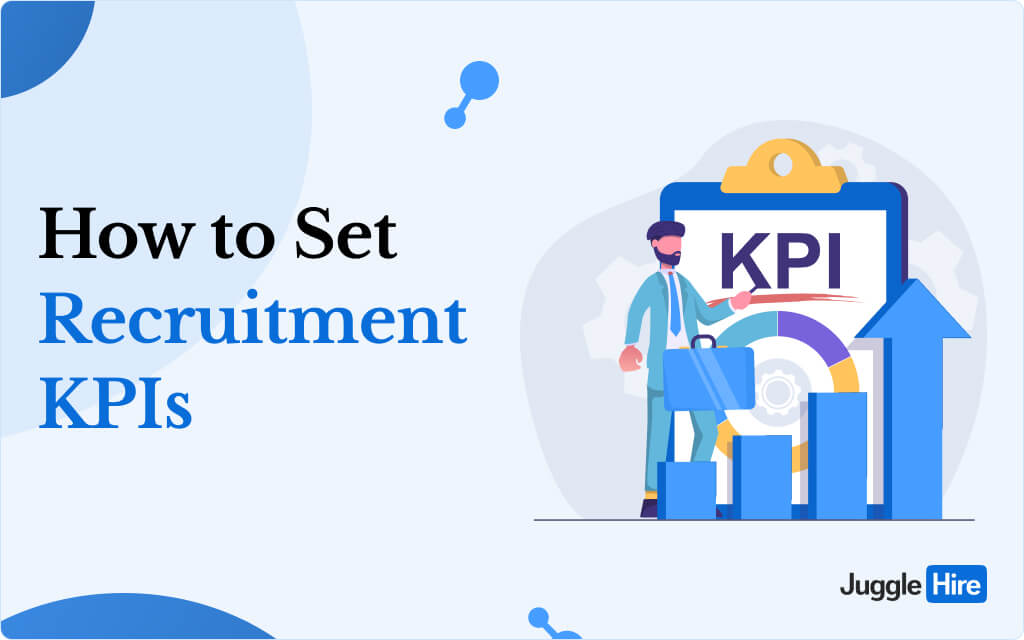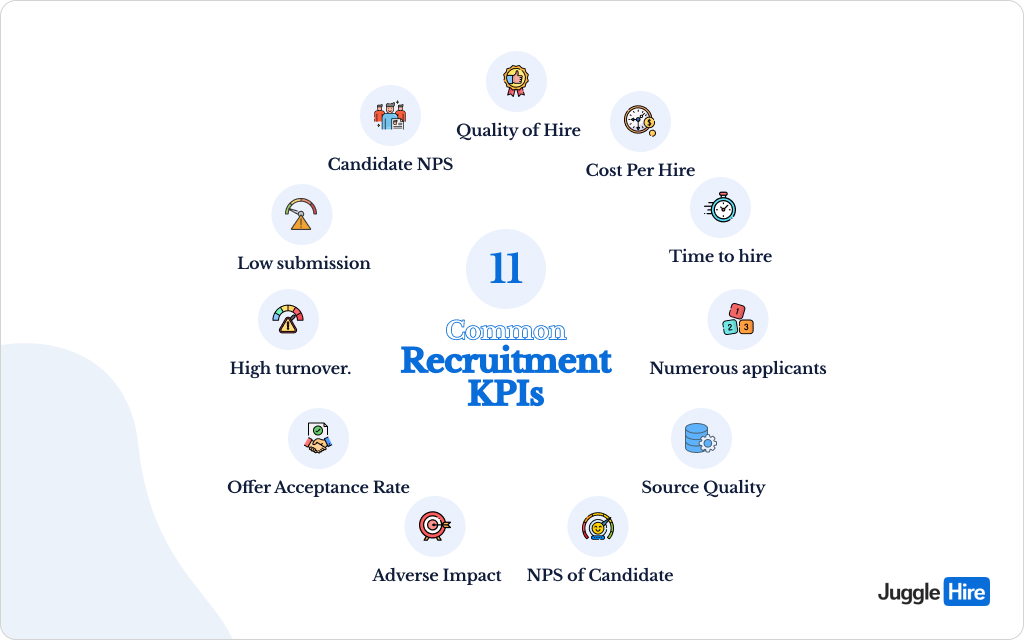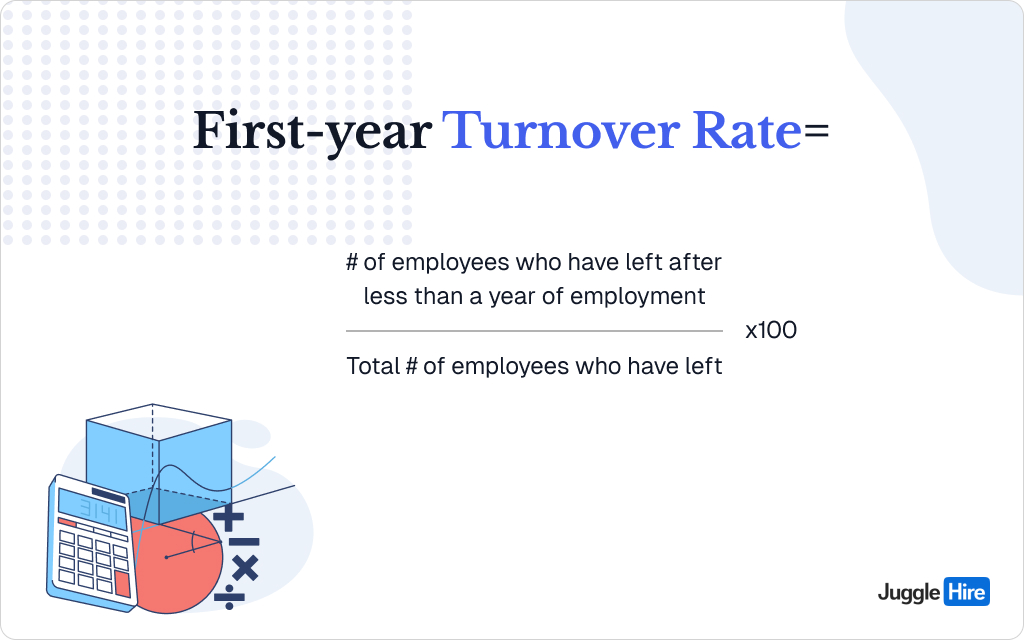How to Set Recruitment KPIs – 10 Common KPIs for Successful Hiring

Recruitment strategies are always changing. You must keep up with the best recruitment practices in order to find the best possible hires. That’s when you need recruitment KPIs.
If you haven’t been using recruitment KPIs, you definitely should. Without these handy metrics, you can’t hire the right candidate even after spending a lot for the recruitment process.
Also, recruitment KPIs are the secret ingredients for finding quality candidates in a short time. They can show you where you are doing great and where you might need a correction.
So, if you are wondering how to detect and set the right KPIs for your organization, you have come to the right place. Today, we will show you how to set recruitment KPIs in the best possible way.
So, let’s get started!
What are Recruitment KPIs?
Recruitment KPIs are like the scorecard for your hiring game. They’re the specific metrics that give you the lowdown on how well your recruitment process and team are doing. These can also be considered as Key Performance Indicators.
These KPIs aren’t just random numbers. They are your secret sauce for understanding whether you are getting closer to your recruiting goals or off track. You can see how effectively you are reaching out to the talent you want through these metrics. So, you can figure out where to tweak things for better results.
Now, when you are eyeballing these KPIs, it is crucial to have a baseline for comparison. You can stack up your numbers against industry benchmarks or take a trip down memory lane.
After that, you can compare them to your past performance, like checking month-to-month or year-over-year trends. That way, you will know if you are hitting home runs or striking out. With this knowledge, you can recruit top talent without burning through your time and budget.
Difference Between Recruitment KPIs and Metrics

Alright, let’s clear up the confusion between recruitment KPIs and metrics. Although people tend to toss these terms around as if they are interchangeable, they are not the same thing.
Recruitment KPIs
First up, we have recruitment metrics. These hard numbers give you the lowdown on different parts of your hiring process. Think about stuff like time to hire, cost per hire, and where your hires are coming from. These recruitment metrics are handy for spotting trends and patterns in your recruitment data. However, they don’t necessarily tell you if you are hitting your goals.
Recruitment Metrics
Now, on the other side of the fence are recruitment KPIs. Usually, recruiting KPIs are percentages or ratios that compare how you are actually doing to where you want to be. These specific recruiter performance metrics line up with your recruitment goals and objectives. With these recruiting KPIs, you will know if you are cutting the mustard or falling short.
Recruitment KPIs vs Metrics
Let’s say you want to improve the quality of your hires. In this case, one metric you might use is the first-year attrition rate. It is just the percentage of new hires who jump ship within their first year. Unfortunately, that number by itself doesn’t tell you whether you are snagging top-notch talent or not. So, they are not the KPIs for talent acquisition.
To really get the picture, you gotta compare it to something, like a benchmark or a target that shows where you want to be. For example, if the average first-year attrition rate in your industry is 15%, and you are shooting for 10% or lower, then that metric turns into a KPI that shows how well is your hire quality.
To help you understand recruitment KPIs vs recruitment metrics, check out the table below.
| Recruitment KPIs | Recruitment Metrics | |
| Alignment | Aligned with goals and objectives | Provide information on aspects |
| Evaluation | Measure effectiveness and efficiency | Track trends and patterns |
| Comparison | Compare actual vs. expected performance | Quantify data |
| Expression | Presented as percentages or ratios | Displayed as numerical values |
Tired of using Recruitee? Want to try something different? Check out –
Top 7 Recruitee Alternatives
How to Set Recruitment KPIs for Hiring Success
Wrapping your head around recruitment KPIs might feel like tackling a tough puzzle. It is especially true if you are new to the whole data-driven recruitment scene. But fear not, we have got the following instructions to guide you through.

Step 1: Choose the Right Recruitment KPIs
First things first, you gotta pick the right recruitment KPIs. Start by nailing down your recruitment goals. Line them up with what your organization is all about. Then, figure out which metrics actually matter for tracking your progress toward those goals.
Once you have got those metrics in hand, cherry-pick the ones that pack the biggest punch for your recruitment success. Set targets or benchmarks to turn them into full-fledged KPIs for recruiters.
Step 2: Define the Number of Recruitment KPIs
Now, you might be wondering, “How many KPIs do I really need?” Well, there is no one-size-fits-all answer to that question. It all boils down to what your recruitment needs and priorities are.
But here’s a rough guideline: shoot for a sweet spot of around 5 to 10 KPIs. That should cover all the bases without drowning you in data overload. Keep them balanced, manageable, and aligned with your recruitment goals. That way, you will have a clear picture of how you are doing without getting lost in the numbers.
Step 3: Measure and Calculate Recruitment KPIs
Time to roll up your sleeves and get your hands on some data. Gather up all the juicy info you need using surveys, interviews, tests, and whatever else floats your boat. Then, whip out your trusty tools like spreadsheets or databases to crunch those numbers. Apply the right formulas to calculate each KPI and boom, you are on your way.
Step 4: Track Recruitment KPIs
Once you’ve got your KPIs all figured out, it is showtime. Regularly check these recruitment KPIs to see how you are stacking up. Present your findings in snazzy formats like reports, charts, or graphs.
And don’t just hoard all that good stuff to yourself—spread the word far and wide through emails, meetings, or whatever gets the job done. The key here? Make sure your KPIs are crystal clear, spot-on accurate, and ready to fuel some serious action.
Know More –
Most Highlighted Benefits of SaaS for Small Business (with Case Studies)
The Most Common Recruitment KPIs That You Must Have
Let’s dig into some of the top-notch recruitment KPIs you should have in your arsenal. No particular order, just good old essentials:

1. Quality of Hire
This one’s all about snagging the cream of the crop. It measures how well your team is at roping in the right folks for the job. Quality’s a bit of a slippery fish—it varies from place to place and depends on what your organization’s shooting for. But fear not, you can gauge it by checking –
- How quickly new hires hit their stride
- How happy do they make their managers
- How snugly they fit into your company’s vibe
2. Cost Per Hire
Show me the money! This KPI tallies up all the expenses to fill a vacant spot in your squad. We are talking ad bucks, referral fees, recruiter hours, you name it. Keeping tabs on this figure gives you the lowdown on your recruitment budget.
By understanding and tracking these hiring KPIs, you can slash costs where you can. Plus, you can size it up against the competition to see how you stack up.
3. Time to Hire
Tick-tock, time is ticking! This one clocks the days from when a candidate steps into the recruitment funnel until they sign on the dotted line. It is like a stopwatch for your hiring process.
Break it down by department or job type to see where you are zipping along and where you are hitting snags. After all, the best fish don’t stay on the market long. So, you need to keep your reels spinning fast.
In addition, know how long it takes to reel in a new hire. This will help you plan for the future, whether you are gearing up for growth or starting a new project.
You might be interested in –
8 Proven Time Management Strategies for HR Professionals
4. Number of Qualified Candidates
It all starts with knowing if you have the right folks in the lineup. Figure out what “qualified” means for each gig. You can do this through manager surveys or tracking who makes the cut for interviews.
This recruitment KPI tells you if your sourcing game is on point or if you are swinging and missing. Tweak the job postings or sharpen up your screening process if you can’t find enough qualified candidates.
5. Source Quality
Ever wonder where all those applicants are coming from? This recruiter KPI spills the beans on which sources are bringing in the big guns. These can be –
- Job Sites
- Agencies
- Job Board Solutions
- Personal Job Platforms
- Social Media Platforms
These recruitment KPIs are directly related to sourcing channel efficiency. If you are tossing cash into a pit with no return, it is time to switch things up. Double down on what’s working. Additionally, ditch the deadweight to build a pipeline that is as solid as a rock.
6. Net Promoter Score (NPS) of Candidate
How do your candidates rate their time with you? These KPIs for talent acquisition give you the scoop on how likely they will suggest your organization to others. To measure these recruitment KPIs, survey all candidates, whether they land the gig or not.
Ask them how much they would recommend your company on a scale from 1 to 10.
- If they rate 1 to 6, they are not likely to recommend (called detractors).
- If they rate 9 or 10, they’re big fans (called promoters).
- Don’t worry about scores of 7 or 8.
Once you have these numbers, you can calculate your NPS with the following formula –
NPS = Percentage of detractors – Percentage of promoters
A high NPS means you’re winning hearts and minds. If it is above 50%, you are doing great! It sets you apart from the competition and makes you the belle of the ball in your industry.
7. Adverse Impact
Keep bias in check with this gem. It flags if your recruitment process is giving certain groups the short end of the stick. Divide applicants into protected and non-protected classes. Then, divide the numbers to see if there is a fairness issue. If there is, it is time to make some tweaks to level the playing field.
8. Offer Acceptance Rate
You have found the perfect match, but will they say “yes”? This recruitment KPI keeps tabs on how many candidates are biting the bait. If your acceptance rate’s on the low side, it might be time to sweeten the deal or spruce up your interview game.
Keep an eye on how much you are offering candidates and see if it matches up with others. If it is not competitive, you might need to offer more. Also, keep track of how long it takes to hire someone to make your job offers more appealing.
To figure out your offer acceptance rate, just divide the number of people who say yes to your job offers by the total number of offers you have made. Easy peasy!
9. Turnover Rate in the First Year
Keep your talent on board with this beauty. High turnover means you are losing cash and maybe even losing sleep. Calculate how many folks are leaving your company before the year’s up and figure out why.
Here is the formula to calculate the first-year turnover rate,

Measuring this recruitment KPI gives you a sign that your recruitment process needs a tune-up. It also suggests that your company culture needs some TLC (Tender, Love, and Care). Get feedback from your employees, both past and present. Accordingly, make the changes needed to keep them happy and hanging around.
10. Submit to Interview Ratio
This one’s all about efficiency. It checks how many candidates are getting the green light for interviews compared to how many are in the running.
Submit to interview ratio = Number of candidates submitted for consideration / Number of candidates interviewed
If your ratio’s out of whack, it could signal problems with sourcing or screening. Ideally, you want a 1:1 ratio—each candidate submitted should be interview-worthy. Keep an eye on hiring manager satisfaction to fine-tune your process. Also, know where your hires are coming from.
Find Out More –
Most Effective Job Interview Tips for Hiring Managers and Candidates
Use JuggleHire to Simplify Recruitment KPIs

Simplify your recruitment KPIs with JuggleHire—it is as easy as pie. Track all your key performance indicators for recruitment in a snap with JuggleHire’s Reports & Analytics feature. From time to hire to offer acceptance rate, it is all right there for you to analyze.
Here are some points on how JuggleHire can help in detecting and simplifying recruitment KPIs:
- Centralizes recruitment data for easy access and analysis.
- Offers customizable reporting tailored to specific KPIs.
- Provides real-time monitoring of recruitment metrics.
- Automates tracking to save time and ensure accuracy.
- Facilitates benchmarking against industry standards.
- Seamlessly integrates with existing hiring processes.
JuggleHire doesn’t just help you find new talent, it helps you keep them happy too. By nurturing a culture of growth and offering opportunities for career advancement, you’ll have employees lining up to stick around for the long haul.
So, if you want to supercharge your recruitment game and keep your KPIs on point, give JuggleHire a spin. Trust us, your future self will thank you for it.
Final Verdict on How to Set Recruitment KPIs
Tracking recruitment KPIs isn’t just about crunching numbers—it is about gaining the insights you need to level up your hiring game. By keeping tabs on these key metrics, you can uncover hidden patterns, spot areas for improvement, and fine-tune your recruitment strategy for maximum impact.
You must have a clear understanding of how your actions affect your hiring outcomes. Only then, you can make informed decisions and drive real results.
JuggleHire is the ultimate tool for supercharging your hiring game. With intuitive features and powerful analytics, JuggleHire makes setting and tracking your recruitment KPIs a breeze. Don’t just take our word for it—book a demo now and start your free trial today!

Hello there I am so happy I found your webpage, I really found you by mistake,
while I was browsing on Digg for something else, Regardlless I am here now and would just like to say thanks for a fantastic post and a
all round thrilling blog (I also love the theme/design), I don’t have time to
look over it all at the moment but I have book-marked it and also added
in your RSS feeds, soo when I have time I will be back to read more, Please
do keep up the awesome work.
Thanks a lot Joel